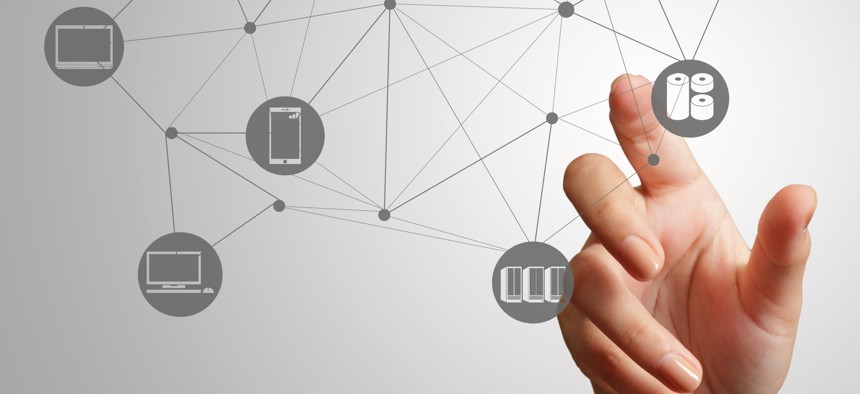sponsor content What's this?
Getting Beyond the Specs: How I.T. Powers Mission

Presented by
Lockheed Martin

With the demands on government rapidly changing, agencies need to rethink how they approach their IT investments
The government of the future depends on technology. With data widely acknowledged as one of the most valuable assets for government, and advances in mobility and analytics changing how citizens interact with government, the needs of government are evolving. Perhaps unsurprisingly, federal spending on information technology is expected to increase 2.7 percent from 2015, reaching $86.4 billion in FY16.
Government needs to be mobile, efficient, flexible and agile—and to do this it needs to have an IT backbone that supports a diverse array of activities. Yet, despite the recognized importance of technology, too often government thinks of IT as a commodity—something to be purchased at the lowest cost acceptable, rather than an integral part of successful operations. Instead of looking at IT as a fundamental driver of mission, some federal leaders see technology more as a series of specs to be met.
In fact, this could not be farther from the case. A properly developed IT infrastructure can help drive mission by providing easily accessible, rapidly deployed, up-to-date data and analytics information that government leaders can use when making critical decisions. Technology is more than just a prop, which is why it no longer makes sense for agencies to view its acquisition in terms of cost rather than value.
“IT is so ingrained in what we do on a day-to-day basis that it has become part of the organization as a whole,” says Scott Gray, vice president of information technology and security solutions at Lockheed Martin. “As agencies mature and modernize their enterprise, they have to view any major IT investments as an organizational change.”
Today, benefit and entitlement programs are analyzing big data to identify fraud, waste and abuse. Law enforcement agencies are using analytics to solve crimes, some of which have gone unsolved for decades. Agencies focused on health outcomes are working with individual and longitudinal data to improve the quality of patient care and enable personalized medicine. Across government, data center consolidation efforts are saving billions through reduced energy and operations costs while simultaneously improving the efficiency, capacity and security of computing efforts.
“The business side, which for government is the mission need, has to drive everything,” Gray says. “Modernization efforts from a business and IT perspective must be fundamentally linked, as their respective leaders too must have a shared voice and vision. Operationally, your business roadmap needs to match an adaptive technology roadmap. When one changes or morphs, the other has to shift to incorporate this new position. Technology has to be supportive of wherever the business is moving.”
So, what does this mean for agencies seeking to adopt this new mindset? According to Gray, agencies should first look at modernization initiatives holistically, acknowledging the fact that over the course of a three- to five-year planning window, technology considerations will likely change at least twice. Given the rapid evolution of IT, agencies need to understand that not all requirements or capabilities will be able to be defined up front. Instead, they should focus on achievable incremental milestones and develop a strategic plan that takes advantage of these changes relative to their individual business needs. To ensure that all solutions meet the security requirements of government, cybersecurity should be incorporated into this planning from the beginning, not bolted on at the end.
Often the best way to approach modernization is through what is commonly referred to as “design thinking”—designing with an eye for what is optimally desirable from a human standpoint while still considering technical feasibility. A good way to get started is for agencies to design backwards from the “point of experience,” or how the end-user will actually engage with the system at hand. End-user experience determines not just satisfaction with a system, but also a system’s accessibility, and can dictate if a system becomes a hindrance or an integral part of operations. To this end, the organization, structure, shape, plan and service delivery of IT has to take into account the end-user experience, as even the most sophisticated technology is of limited utility if it is not easily usable.
With so many moving pieces at play, this process might seem overwhelming at first. However, proper management and strong leadership can help reduce growing pains. Often, agencies find it helpful to hire a change management expert to oversee this process, or to work with outside teams to understand how best to implement IT in a manner that is sensitive to the needs of government. Although these organizational steps might seem unnecessary, they can help ensure that an agency’s business and technical goals remain aligned, moving them smoothly from their current condition to their desired future state.
“What we need to think about is the entire evolution, which includes behavioral transformations from your workforce and from your end-users in terms of acceptance, utilization and value of the system,” Gray says. “Do not try everything at once. It is important to understand how well the organization is positioned to adopt the transformation, and as such it’s crucial to double down on change management, education and communication.”
About Lockheed Martin
Modernizing infrastructure means going beyond enterprise systems that just keep up with today’s demands. Lockheed Martin offers solutions made for the future that are suited specifically to our customers’ needs, all while expanding their overall capabilities. Adaptive technology and innovation have made Lockheed Martin the ally for teams facing complex missions. Learn more at www.lockheedmartin.com/IT
This content is made possible by our sponsor. The editorial staff of Nextgov was not involved in its preparation.


